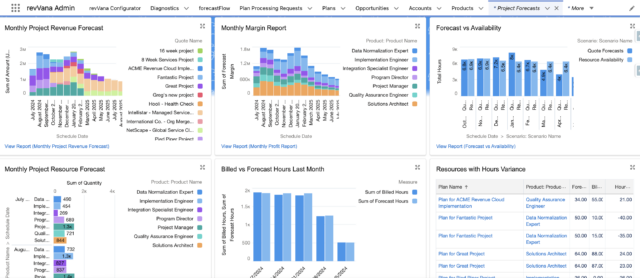As services are becoming increasingly project-based, the ability to accurately forecast labor and revenue is vital. Businesses today are challenged with managing complex projects, optimizing resource allocation, and projecting revenue with precision. Companies that can accurately forecast streamline operations and gain a strategic advantage by predicting their financial future more accurately.
At the heart of effective forecasting lies the ability to align resource planning with real-time data, creating transparency across teams and ensuring that projects stay on budget and on schedule. The question isn’t just about gathering data; it’s about making that data work for you—enabling your organization to pivot when needed, avoid resource gaps, and prevent overspend.
The Challenges of Forecasting in Professional Services
Professional services firms face unique forecasting challenges. Unlike product-based businesses, where revenue is relatively predictable, service-based businesses depend heavily on their ability to manage people and projects. This means that resource availability, project timelines, and labor costs must be meticulously planned to ensure profitability.
Manual forecasting methods often fail to provide the granularity needed for these businesses to thrive. Instead of offering insights into how workloads and revenue evolve throughout a project, these systems typically present static snapshots of opportunity pipelines. However, forecasting requires more than a broad view. It demands a granular understanding of how different roles—implementation engineers, project managers, solutions architects—are involved at different stages of a project, and how that involvement impacts timelines and costs.
Without this level of visibility, companies risk missing out on key insights, such as whether they have enough staff to complete upcoming projects, or if they’re overburdened, leading to potential delays and increased costs. A lack of integrated forecasting tools can also result in missed opportunities to optimize revenue, as companies struggle to adjust project plans and staffing levels in response to real-time changes.
Balancing Resource Allocation with Future Demand
The key to effective forecasting is balancing current resource availability with future demand. It’s not just about filling project roles today, but predicting what roles you’ll need in the future and how they’ll evolve over the course of a project. Forecasting allows managers to take a forward-looking approach, identifying both upcoming resource gaps and surpluses.
For instance, knowing that certain roles—like implementation engineers—are typically front-loaded with work, while project managers might be spread evenly throughout the project lifecycle, allows for more strategic staffing decisions. By mapping out the project timeline, organizations can adjust hiring plans, allocate additional resources, or even delay projects to ensure that teams are neither overextended nor underutilized.
But resource allocation isn’t just about managing people; it’s also about managing profitability. With insights into how resource usage impacts the bottom line, companies can make more informed decisions about pricing, staffing, and project timelines. Ultimately, these decisions determine the profitability of each project, and by extension, the overall financial health of the business.
Integrating Forecasting with Broader Business Goals
To best forecast, it needs to be integrated with broader business goals. This means breaking down silos between departments, aligning financial forecasting with project management, and creating a seamless flow of data across the organization.
For companies using multiple systems, such as Salesforce for customer relationship management (CRM) and a professional services automation (PSA) tool for resource management, ensuring that these systems are synchronized is crucial. When sales forecasts, resource plans, and financial projections are disconnected, it becomes difficult to get a true picture of business health. By integrating these systems, businesses can see not only how projects are tracking against revenue goals but also whether they have the resources to meet future demand.
Businesses that can accurately forecast labor and revenue over time are better equipped to make proactive, rather than reactive, decisions. They can adjust to market changes, plan for growth, and ensure that they’re using resources as efficiently as possible—all while keeping the business profitable.
Leveraging Technology to Enhance Forecasting
This is where platforms like revVana come into play, offering a powerful integration with Salesforce to streamline both quoting and forecasting processes. By providing real-time insights into project staffing, resource availability, and revenue forecasts, revVana helps businesses make decisions to optimize both operations and profitability.
For example, revVana allows businesses to create tailored project plans that reflect actual resource needs at different stages of a project. It integrates seamlessly with Salesforce, enabling real-time updates to quotes and pricing as project staffing or timelines shift. This dynamic, two-way integration helps businesses stay on top of their projects and make adjustments as needed to avoid overspend or resource shortages.
Additionally, revVana’s ability to integrate with PSA systems, such as FinancialForce or OpenAir, ensures that both Salesforce data and PSA data feed into one unified forecast. This enables organizations to have a clear view of project timelines, billed hours, and resource allocation, while also providing the granularity needed to optimize revenue projections.

Forecasting Automation
By automating the forecasting process, platforms like revVana free up valuable time that would otherwise be spent on manual data entry and reconciliation. With automated forecasts and detailed reports, businesses can quickly identify which projects are over or under budget, ensure timely delivery, and avoid costly delays.
Moreover, revVana’s integration with Salesforce’s analytics tools offers insights into which resources are most profitable, helping businesses adjust their pricing and staffing models to drive long-term growth.
Watch our webinar on quoting and forecasting services for a deeper dive into the tools and strategies that can help your business stay ahead.






